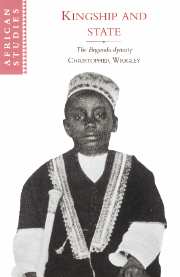Book contents
- Frontmatter
- Contents
- List of illustrations
- Preface
- Notes on language
- List of abbreviations
- 1 Preamble
- 2 The story and its making
- 3 Introduction to myth
- 4 Introduction to Buganda
- 5 The remoter past
- 6 Genesis
- 7 The cycle of the kings
- 8 Fragments of history
- 9 Foreign affairs
- 10 The making of the state
- 11 Reflections
- Notes
- Bibliography
- Index
- Other books in the series
6 - Genesis
Published online by Cambridge University Press: 12 January 2010
- Frontmatter
- Contents
- List of illustrations
- Preface
- Notes on language
- List of abbreviations
- 1 Preamble
- 2 The story and its making
- 3 Introduction to myth
- 4 Introduction to Buganda
- 5 The remoter past
- 6 Genesis
- 7 The cycle of the kings
- 8 Fragments of history
- 9 Foreign affairs
- 10 The making of the state
- 11 Reflections
- Notes
- Bibliography
- Index
- Other books in the series
Summary
Sun and moon
Thanks to a slight northward tilt of the plateau, nearly all the waters of Buganda actually flow away from the great Lake, in slow papyrus-choked streams which wind their way towards the Nile as it turns westward through Lake Kyoga. Only the Nile itself, to the east of the ancient kingdom, has breached the line of hills fringing the northern coast of Nalubaale. It is not surprising that many of the key places in Buganda's history should lie on this narrow watershed between the Lake shore and its hinterland. The moving capitals of the nineteenth-century kings were always on one or other of the hills overlooking Murchison Bay, within the boundaries of modern Kampala or not far away. A few miles just south of west is Buddo where, since the middle of the eighteenth century, the rites of the king's installation have been performed. Further to the west, near the end of a long swampy finger of the Lake, the shrine of the war-god Kibuuka at Mbaale, ‘the Rock’, was a major focus of patriotic sentiment.
However, there is reason to think that the most ancient nucleus of the realm was further away from the Lake, in the lands lying almost encircled by the two branches of the upper Mayanja river, which have their sources close together just north of Kampala. This was Busiro, ‘the land of tombs’. The modern county of that name extends southward to the Lake shore, including Buddo and the seat of British and later governments at Entebbe; but the name properly belongs only to the northern area, containing all the shrines in which the decorated jawbones of the early kings were preserved.
- Type
- Chapter
- Information
- Kingship and StateThe Buganda Dynasty, pp. 79 - 121Publisher: Cambridge University PressPrint publication year: 1996

